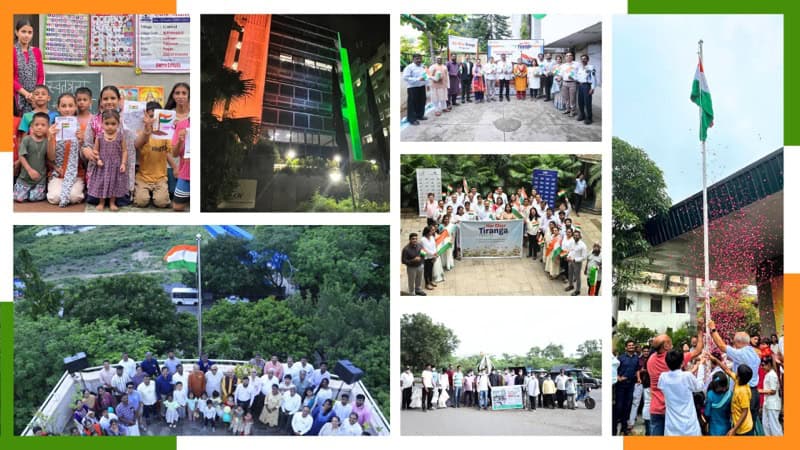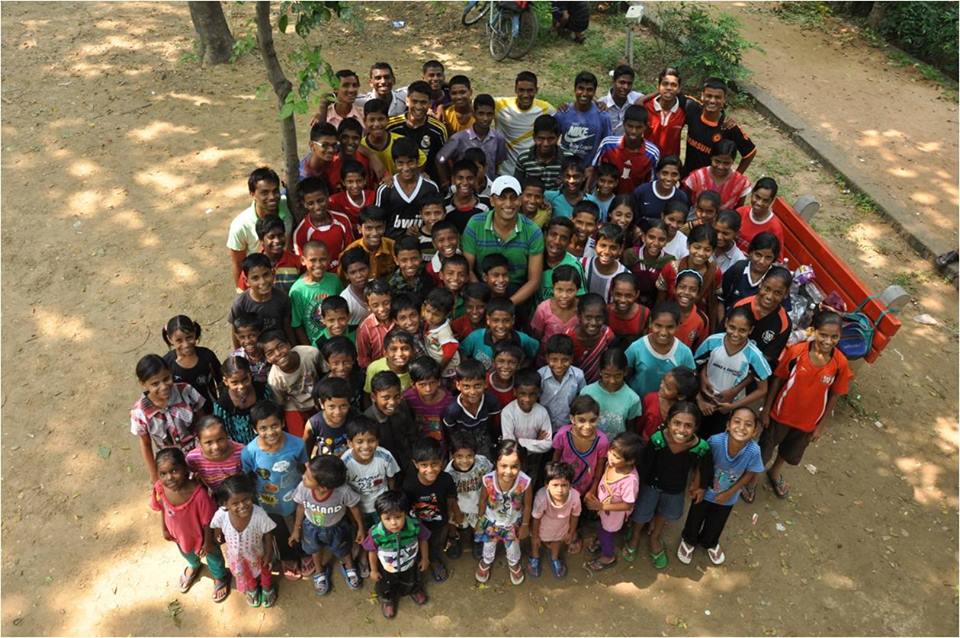As part of the India@100 Fireside Chat series, which convenes visionary leaders to reflect on India’s journey toward 2047, Pirojsha Godrej shared his insights on the future of Indian cities. Widely regarded as a pioneer in the country’s green building movement, he spoke about his personal commitment to sustainability and his vision for creating resilient, inclusive, and future-ready urban ecosystems.
The discussion highlighted sustainability as a cornerstone of urban planning, the transformative role of emerging technologies such as AI, IoT, and smart infrastructure, and the need to integrate global best practices in the circular economy. Mr. Godrej also emphasized the critical responsibility of today’s business and policy leaders to build a lasting legacy of sustainable growth, resilience, and inclusivity—so that by India@100, the nation stands as a global benchmark for sustainable urban development. We have archived this interesting conversation for you. Click the link below to watch it.

In observance of the World Tourism Day (September 27), India@100 organised a Fireside Chat with Puneet Chhatwal under the ” I have a Dream ” series. Mr Chhatwal offered an insightful perspective on how tourism and hospitality can shape India’s global narrative over the next 25 years. He described the sector as a unique force that bridges cultures, amplifies India’s soft power, and creates sustainable livelihoods, particularly in Tier-2, Tier-3 cities and rural regions.
The discussion highlighted the need for forward-looking policies, world-class infrastructure, and dynamic partnerships to elevate India into the league of top global destinations by 2047. Mr Chhatwal envisioned a future where tourism not only showcases India’s heritage, diversity, and hospitality but also drives inclusive economic growth and positions India as a global benchmark in cultural and experiential excellence. Don’t miss his insights. Click the link below to listen to the complete conversation.

On the occasion of the World Food Day (October 16), Mr Sivakumar writes about the importance of empowering rural communities and of building a resilient and sustainable agriculture sector.
Sowing Seeds of Resilience and Sustainability: Agriculture’s Vital Role in Shaping India@100
When India celebrates its centenary of independence in 2047, agriculture will remain one of the most powerful threads weaving together the nation’s growth story. For centuries, farming has been more than a source of food; it has been a way of life, a source of livelihood, and a pillar of identity for millions of Indians. As the country moves toward India@100, the agriculture sector must continue to transform itself to build resilience, nurture sustainability, and take its rightful place on the global stage.
Agriculture has already been central to nation-building. The Green, White and Blue Revolutions have helped India move from scarcity to self-sufficiency, ensuring food security for a growing population. Today, agriculture employs nearly half of the workforce and supports the nutritional needs of 1.4 billion people. Yet the sector is no longer just about producing more. Its role is to secure the future of farmers, regenerate natural resources, and ensure that rural communities thrive alongside urban ones. India’s agriculture transformation must be about resilience, inclusion, and prosperity.
Resilience will be one of the defining needs of the coming decades. Farmers are at the frontlines of climate change, experiencing floods, droughts, heatwaves, and shifting rainfall patterns. To cope with these risks, India must expand climate-resilient approaches. Simple techniques like intercropping and efficient irrigation systems can help farmers withstand weather shocks. Digital tools, from weather apps to remote sensing, allow timely decision-making. Strengthening crop insurance, diversifying cropping systems, and investing in stress-tolerant seed varieties can help farmers reduce vulnerability. Translating scientific agronomy knowledge into farmer-friendly advisories, supported by digital platforms, will allow timely, location-specific solutions. Expanding micro-irrigation and making soil health testing routine can help farmers protect their land while improving productivity. Resilience is not only about bouncing back after a crisis but also about anticipating and preparing for challenges before they strike.
Alongside resilience, sustainability must become the cornerstone of agricultural growth. Soil degradation, water scarcity, and biodiversity loss are not abstract concerns; they are daily realities for farmers. Building back natural capital through organic amendments, water-efficient practices, and integrated pest management can restore productivity while protecting the environment. India also has an opportunity to lead in low-carbon farming. Renewable energy for irrigation, turning farm waste into value-added products, and developing carbon markets that reward regenerative practices are pathways that can align agriculture with the country’s net-zero 2070 goals. A reformed subsidy framework that encourages balanced fertiliser use and links incentives to soil health and nutrient efficiency can strengthen sustainability while safeguarding farmer affordability.
The heart of agriculture, however, lies in the empowerment of farmers and rural communities. Farmers are not passive recipients of policy but active agents of change. Strengthening farmer-producer organisations and cooperatives can give them bargaining power and market access. Easing regulatory processes for FPOs by treating them as no different from individual farmers and incentivising them through supportive measures can accelerate their role as engines of inclusive growth. Establishing dedicated funds for scaling successful FPOs, while enabling access to CSR resources, can help these groups transform fragmented holdings into collective strength. Encouraging young people to see farming as a modern, technology-driven enterprise can inject new energy into rural economies. Women, who make up a significant share of the agricultural workforce, need recognition, skills, and access to resources so that their contributions are fully realised. Access to finance, storage, logistics, and fair markets will ensure that farming is not just about subsistence but about dignity and prosperity.
In the global context, India has a unique opportunity. The world is looking for sustainably grown and traceable food. With its diverse agro-climatic zones and rich farming traditions, India can position itself as a hub for sustainable agricultural products. Building global competitiveness will mean investing in quality standards, strengthening traceability systems, and creating brands that reflect the trust and resilience of Indian farmers. Creating an enabling environment for innovation, from seeds to digital farm solutions, will also help Indian agriculture match global benchmarks while empowering farmers with new choices. The challenge is to balance this export orientation with the equally important need to ensure food and nutritional security at home.
As India moves toward 2047, agriculture will remain more than a sector of the economy. It will be a mirror of how the nation values resilience, equity, and sustainability. India@100 is not about choosing between growth and sustainability. It is about weaving them together into a story of resilience, dignity, and global leadership.
India’s tryst with destiny began in the fields, and its journey to 2047 will be carried forward by the same soil that has always sustained its people. To nurture agriculture is to nurture the nation itself.
CHANGESPEAKE
CHANGESPEAKE is a series of conversations featuring individuals who, through their beliefs and passion, are shaping the contours of an inclusively developed India@100. We hope the series will motivate others to emulate these best practices and also build their ability to open new frontiers for the country. Doing so will help accelerate change and build the momentum that India needs to reach its ambitious goals for 2047.
“Digital access isn’t just an infrastructure issue—it’s a civil rights issue in the making. If 48% of schools are offline, nearly half our children are already locked out of India@100.”

What inspired you to become a teacher, and how did your early experiences shape your philosophy of education?
I never planned to become a teacher. My dream was to become an engineer. But after facing persistent mental and physical harassment in engineering college, I dropped out, feeling broken and directionless. In that moment of crisis, my father said something that changed everything: “Go to a teacher’s college—you’ll be surrounded by good people who will help you grow again.”
That advice became the turning point of my life. At teacher’s college, I found not just a new environment, but a new version of myself. For the first time, I was in a space where I was not judged, but believed in. My teachers didn’t just teach—they transformed. They rekindled my sense of worth and purpose. I realized that real changemakers aren’t always in high offices or headlines—they are in classrooms. And they had just changed me.
That experience didn’t just make me a teacher—it made me an advocate for systems that don’t fail children the way mine did. It shaped how I think about education policy today: as a tool not just for knowledge transmission, but for human restoration.That realization planted the seed for my philosophy of education: that teaching is not a profession, it is an act of nation-building. I came to believe that a great teacher doesn’t just deliver content—they unlock potential.
As Nelson Mandela once said, “Education is the most powerful weapon which you can use to change the world.” I am living proof of that. And that’s why I chose to become a teacher—because I wanted to pass on the power of transformation I had experienced myself.
You won the coveted Global Teacher Prize 2020 award and decided to share half the amount of the prize money among fellow finalists. What inspired you to make that gesture—and how did it eventually shape the birth of the Ranjitsinh Disale Foundation and the idea of borderless classrooms?
When I was announced the winner of the Global Teacher Prize in 2020, I felt a deep sense of gratitude—but also a clear responsibility. For me, leadership isn’t about standing tallest on the podium—it’s about raising others alongside you. That’s why I made the deliberate choice to share 50% of the prize money with my fellow finalists. As I’ve always believed: teachers work for outcomes, not incomes.
I wanted to empower educators who, like me, were transforming lives under the radar. I knew this gesture could unlock opportunities far beyond what one person could do alone—and I’m proud of what we’ve achieved together. That shared fund has supported 42 students from Italy and the United States in pursuing their education. It’s helping children with special needs in Brazil, feeding hundreds of students daily in South Africa, and even contributed to building two new schools in Nigeria.
This impact inspired the creation of the Ranjitsinh Disale Foundation, rooted in the vision that every child, everywhere, deserves access to quality education. Through our global initiatives—including peace education, community-driven school models, and cross-cultural collaborations—we’re working to make that vision a reality. The Foundation is not a charity—it’s a platform for peer-led action. Built on the belief that when educators lead from the frontlines, change becomes sustainable.
The Global Teacher Prize was not the end of a journey—it was the beginning of a movement. A movement where teachers support teachers, where classrooms reach beyond borders, and where every child, no matter their background, gets a fair chance to learn and thrive.

Global Teacher Award 2020 winner Ranjitsinh Disale in his classroom. Credit: Vaibhav Gadekar
At the heart of your initiative, #GiftANewBeginning, lies a powerful belief in second chances. What is the core philosophy driving this movement, and how will you know when it’s truly making a difference?
#GiftANewBeginning is not about second chances. It’s about restarting—with a new approach, a renewed mindset, and a belief that the old ways are not the only ways forward.
This initiative was born from a realization that education systems often fail not just because of lack of resources, but because of outdated assumptions—about learners, about teachers, and about what’s possible. Too often, we try to fix problems using the same tools that caused them. #GiftANewBeginning is about disrupting that cycle. It’s about asking bold questions, designing new models, and embracing solutions rooted in empathy, relevance, and innovation. Whether we are reimagining classrooms for children in crisis zones, designing adaptive learning kits for marginalized communities, or launching teacher fellowships that reward creative risk-taking, the goal remains the same: to redesign the journey, not just resume it.
Our partnership with India Exim Bank, under their CSR initiative, is a perfect example of this approach in action. By working closely with public schools—providing tools, building sustainable infrastructure, and continuously monitoring learning outcomes through evidence—we’re showing what #GiftANewBeginning truly stands for.
I’ll know this movement is working when we stop measuring success by old benchmarks—and instead, start seeing learners who are curious again, teachers who are fearless again, and communities that believe again.
If this vision resonates with you, I invite you to stand with us. This is not just a campaign—it’s a call to action. A call to rewrite how we think about learning, opportunity, and change. Because the future doesn’t come from going back. It comes from starting forward—with a new beginning.
India has made significant strides in digital education, but challenges persist—especially in rural and underserved regions. In your view, does the current digital infrastructure adequately support equitable access to technology-enabled learning? What targeted steps should we take to bridge these gaps?
Digital access isn’t just an infrastructure issue—it’s a civil rights issue in the making. If 48% of schools are offline, nearly half our children are already locked out of India@100. When I introduced QR-coded textbooks, students didn’t have smartphones. That gap between innovation and infrastructure taught me that brilliance without bandwidth is a broken promise.
If you look at the UDISE+ 2023 data, only 52% of government schools in India have internet connectivity. This highlights a significant gap in our digital infrastructure that continues to limit equitable access to technology-enabled learning. While electricity is available in over 90% of schools, internet access remains a bottleneck.
To bridge this gap, we must move beyond aspiration and focus on grounded, achievable goals. Too often, we announce ambitious ed-tech visions without investing in the basics. The first step is to set realistic, region-specific targets for digital infrastructure expansion—starting with the most underserved blocks.
Second, we need a data-driven approach. We must use school-level data to map infrastructure gaps, assess device availability, and track teacher readiness. Digital equity is not just about fiber optics—it’s about understanding who is left out and why.
Lastly, no single actor can do this alone. Edtech firms, telecom providers, and governments must work in partnership, not isolation. The private sector’s innovation, paired with the government’s reach, can create meaningful access for the last-mile learner.
You’ve been a strong advocate of girls’ education. How can we scale such efforts nationally to build an India@100 where no child is left behind?
To be honest, I don’t believe scaling “my” effort is the answer. Real transformation happens when we enable communities to lead their own change. In my village, I didn’t start with big resources—I started by listening to parents who feared sending their daughters to school. It was slow, local, and personal.
Scaling girls’ education in India@100 means unleashing the changemaker potential in every community—especially among teachers, mothers, frontline workers, and local leaders. If each village had just one trusted advocate for girls’ education, we wouldn’t need to replicate outside models. We’d build inside-out solutions.
But empowerment alone isn’t enough—we must also remove structural barriers. Girls drop out not because they lack talent, but because of child marriage, unsafe travel, or the burden of unpaid work. Scaling efforts means addressing these intersections holistically.
Lastly, we need to redefine success. It’s not just about enrollment or completion rates. It’s about dignity, agency, and ensuring every girl has the tools to shape her future.
An India@100 worth building is one where every girl—not just enrolled but empowered—leads the way for her community. That’s not a dream. I’ve seen it happen. I would encourage CII members to join me in this mission—to empower girls not just to participate, but to lead. Because when girls lead, communities rise.
At India@100, our goal should be clear: not one child less—not one girl unseen.
Swachhata Hi Seva 2025

As part of its commitment to building a cleaner and more sustainable India, the India@100 Foundation actively participated in the nationwide Swachhata Hi Seva campaign. Aligned with the theme of a Swachhotsav, the initiative mobilized communities and stakeholders to promote cleanliness, effective waste management, and environmental stewardship. Through awareness drives, on-ground activities, and volunteer engagement, the campaign demonstrated the power of collective action in creating healthier and more resilient urban and rural ecosystems.
10 years of Make in India

As ‘Make in India’ completed a decade, the milestone was celebrated through a series of sectoral and regional programmes highlighting India’s manufacturing and innovation journey. The engagements brought together industry leaders, policymakers, entrepreneurs to reflect on the nation’s strides in industrial growth, digital transformation, and sustainable development. The commemoration also reaffirmed Make in India’s enduring contribution to empowering industries, nurturing startups, and inspiring future talent — reinforcing the vision of Atmanirbhar Bharat and Viksit Bharat.




